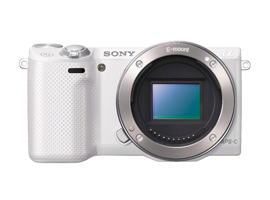Introduction


With an overall DxOMark Score of 78, the NEX-5R places 28th in the DxOMark rankings. It beats its predecessor, the NEX-5N, by only one point, which clearly indicates that it uses the very same sensor.
The NEX-5R jumps 5 places ahead of the Sony SLT-A57, the DSLR equipped with the same sensor but somewhat handicapped in low-light sensitivity by its use of Translucent Mirror Technology. The NEX-5R also jumps ahead of the Canon EOS 1D Mark IV by 9 places as well as the Fujifilm X100 – a camera of reference – by 10 places.
For color depth, the NEX-5R scores 23.7 bits, so no improvement here with respect to the NEX-5N.
The NEX-5R delivers a maximum dynamic range of 13.1EV, a very honorable score that puts it into 15th place in the DxOMark rankings. However, as far as this precise criterion goes, the NEX-5R is still beaten by several other cameras equipped with apparently similar sensors, such as the Nikon D5100 and D7000, which measure 13.6 and 13.9EV, respectively, as well by as the Pentax K-5, currently in first place among APS-C cameras for dynamic range with a score of 14.1EV. We note a slight improvement of 1/3EV over the NEX-5N (a difference that is hardly noticeable on final print images).
For low-light sensitivity, the Sony NEX-5R achieves a score of 910 ISO, which puts it in 39th place in the DxOMark rankings. By comparison, the camera with the most sensitive APS-C sensor in this category, the Nikon D5100, racks up a score of 1183 ISO. This is a big difference in terms of absolute values, but translates into an improvement of only 1/3EV, which is scarcely noticeable on a print.
The Sony line of compact hybrids also includes the NEX-F3, which shares its 16Mpix CMOS sensor with the NEX-5R. The NEX-5R scores 5 more points on the DxOMark scale than the very consumer-oriented NEX-F3 — a difference is achieved thanks to the NEX-5R’s 100 ISO setting (the NEX-F3 starts at 200 ISO), which improves the maximum dynamic range that the sensor can deliver (2/3EV greater for the NEX-5R than for the NEX-F3).
Sony NEX-5R vs Olympus OM-D E-M5
During our tests of the Olympus OM-D E-M5, we found that the manufacturer’s new 16Mpix LiveMOS 4:3 sensor had largely caught up in every category, starting with a dynamic range that allows it to rejoin the field of APS-C compact hybrids in terms of image quality (though with the Sony NEX still ahead).
With a DxOMark overall score of 78, the NEX-5R’s APS-C sensor stays above the Olympus sensor results, but Sony’s lead has been somewhat diminished with respect to the micro 4:3 — only a half-stop better for color depth (23.7 vs 22.8 bits), 2/3EV better for dynamic range (13.1EV vs 12.3EV), and equivalent low-light sensitivity.
The differences between the low-light ISO, color depth, and dynamic range scores are principally due to the Sony’s newly-available 100 ISO minimum sensitivity, whereas the Olympus’s minimum is 200 ISO.

Olympus will also be using the same sensor used in the OM-D E-M5 for its recently-announced more affordable models, the Pen E-PL5 and Pen E-PM2, which we will be testing shortly.
Sony NEX-5R vs Panasonic G5
Pitted against the aging 4:3 sensor design of the Panasonic compact hybrids, the Sony NEX-5R sensor scores points.
The color depth of the NEX-5R sensor is 1.5EV higher, for slightly finer gradations. Its dynamic range is also more generous, with a gain of 1.5EV (13.1EV for the NEX-5R versus 11.6EV for the DMC-G5), or one and a half stops larger.
Finally, for low-light sensitivity, with 618 ISO for the Panasonic sensor versus 910 ISO for the Sony EXMOR sensor, the NEX-5R wins by half a stop.

The Sony NEX-5R delivers good results with excellent dynamic range and elevated low-light sensitivity for a sensor of this size, thanks to its minimum sensitivity setting of 100 ISO. This Sony mid-range hybrid compact should enjoy the same kind of success as its predecessor. However, Sony cannot rest on its laurels: even though Sony maintains an edge over its competitors, the results for the Olympus OM-D and Pen lines show that the gap has been reduced.







DXOMARK encourages its readers to share comments on the articles. To read or post comments, Disqus cookies are required. Change your Cookies Preferences and read more about our Comment Policy.